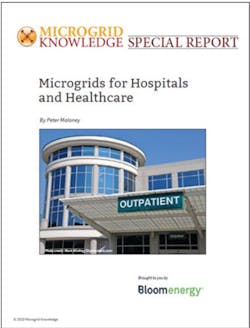Mission to Care — Examples of Microgrids and Fuel Cells in Action at Hospitals
We complete our new special report series on energy opportunities in healthcare with examples of hospital microgrids that use fuel cells to lower costs, improve sustainability, and increase energy reliability.
Hospitals must be built to provide a unique combination of durability and human service. They have to be rugged enough to run 24/7/365 and withstand severe weather and sudden spikes in usage, and they have to be able to provide care in a detailed and compassionate manner that often relies on technology that is highly dependent on reliable electricity. One aspect of hospital infrastructure reflects both realities: the electric plant.
Get the full report.
Hospital electrical infrastructure has evolved with the times. To ensure reliable power, hospitals made diesel generators their go-to solution for decades. They were readily available, and fuel could be stored on-site. In recent years, however, natural gas solutions have increasingly been seen as a viable and often superior alternative to diesel engines.
According to a March 2019 report by the Joint Institute for Strategic Energy Analysis, “natural gas generators are less likely than diesel generators to fail during a power outage.” The report also found that “grid-connected generators run for backup as well as additional services have higher reliability due to more frequent operation, and lower net costs than generators used solely for backup.”
While gas generators are well suited for the rugged needs of hospital reliability, they fall short on a hospital’s mission to care. Gas generators and CHP plants may both be reliable, but they also emit pollutants that can be particularly dangerous to the at-risk population of a hospital. Gas generators are also noisy.
This is why some hospitals are turning to another alternative, fuel cells.
Concerned about diesel generators operating near the windows of at-risk patients, one leading healthcare provider has been exploring ways to reduce or eliminate diesel generators from their facilities. That organization began deploying fuel cells at their facilities in 2012 to reduce operational costs and improve local air quality, which became an even more urgent concern during the COVID-19 crisis, according to a study by the Harvard T.H. Chan School of Public Health. The aforementioned healthcare provider’s vision for the future is to enable fuel cell powered microgrids to reduce, or even eliminate, reliance on diesel generators.
Fuel cells run on hydrogen, which can be sourced directly, but in commercial applications hydrogen for a fuel cell is derived more frequently from natural gas or biogas, which is a renewable fuel. Fuel cells also use little water during normal operations, which is an important consideration in many regions where drought has become more common.
Sustainability was also a driving force for Sutter Health, a not-for-profit health system in Northern California, that wanted a state-of-the-art medical center incorporating advanced technology and green building practices. In its effort to achieve LEED Gold status, Sutter used a Bloom Energy Server at its Santa Rose Regional Hospital. The fuel cell provides power for the hospital while decreasing carbon dioxide emissions by more than 600,000 pounds per year, reducing the hospital’s carbon footprint by 19%.
By Johan Swanepoel/Shutterstock.com
Other technologies, such as solar panels, are sustainable, but they also have shortfalls. Medical technology company Medtronic installed a 320 kilowatt (kW) solar array at its Fountaingrove facility in Santa Rosa, California, in 2011 in an effort to reduce carbon emissions by 15% by 2020, but the company wanted further reductions in emissions and energy costs. So, Medtronic installed a 400 kW Bloom Energy Server that is capable of providing 96% of the electrical requirement for the Fountaingrove B building, while also generating an estimated $2.3 million in energy savings over 15 years.
Installation of the Bloom fuel cells increased the percentage of on-site electrical generation from about 13% to more than 85%. It also reduced CO2 emissions by 19% and will save three million gallons of water every year from being used by thermoelectric plants.
Several other hospitals have already turned to microgrids to improve reliability and lower costs. And these hospital microgrid case studies are already seeing success. Since 2009, Utica College and Faxton-St. Luke’s Healthcare in New York have operated a 3.4 MW microgrid to provide the bulk of their power needs as well as backup power in case of a grid outage. Hospitals in Boston, Florida, New Jersey and Texas have also installed microgrids, often incorporating CHP plants that can provide around-the-clock power, as well as heating and cooling.
As sustainability concerns continue to grow in the face of the rising threat of climate change, the combined goals of improving reliability and reducing emissions are likely to make fuel cell microgrids even more attractive.
A microgrid at the heart of the physical plant of every hospital may become the standard for the hospital of the future. And, in many cases, it’s essential right now. Using an array of resource — fuel cells, solar panels, battery storage devices, and smart software and controls — microgrids offer a way for healthcare to lower energy costs, increase sustainability and ensure that life-sustaining electricity is always available.
Catch up on the first entry in the series here, that outlines a recent turning point for healthcare microgrids. The second highlighted healthcare microgrid types growing as options for critical facilities to avoid outages. Next up was an exploration of how microgrids in hospitals can bolster public health efforts, and the series then moved on to different business models.
Download the full report, “Microgrids for Hospitals and Healthcare,” free of charge courtesy of Bloom Energy.
